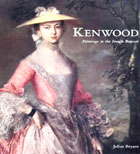Book Review: Kenwood: Paintings in the Iveagh Bequest
Francis Russell applauds a new catalogue of paintings which marks the 75th anniversary of the opening of the Iveagh Bequest at Kenwood.


This handsome catalogue of the outstanding collection of pictures at Kenwood celebrates the achievement of Edward Cecil Guinness, 1st Earl of Iveagh, who bequeathed the house and a significant portion of his collection to the nation in 1927. A useful introductory essay about Iveagh's career and purchases, mostly of 1887-1891 through Agnew, is followed by full entries both for the pictures selected for the house and for those subsequently acquired to complement these.
Iveagh's tastes were plutocratic. He bought masterpieces by the great northern masters, Van Dyck, Rembrandt and Cuyp, Hals and Vermeer: he bought 18th-century French pictures; above all, he bought British portraits - Reynolds and Gainsborough, Romney and Hoppner, Raeburn and Lawrence - and, from his own century, works by Landseer.
Mr Bryant is at his best with the English portraits, although occasionally one senses that social interpretations are strained: I doubt the suggestion that the Finch sisters were painted 'to help attract suitors', and do not believe that, when ordering pendant canvases from Gainsborough, Lord and Lady Howe fancied that she had 'relegated [him] to a lesser portrait'.
Mr Bryant rightly stresses the importance Guinness must have given to provenance, acquiring groups of pictures formerly owned by the 3rd Marquess of Lansdowne and the 2nd Viscount Palmerston, both remarkable connoisseurs. The former's acquisition of the great Rembrandt self-portrait surely suggests a conscious rivalry with his brother-in-law Lord Ilchester, who possessed the even more monumental one now in the Frick Collection. Only a handful of Iveagh's French pictures are at Kenwood, but the sources of these are particularly revealing: the Bouchers had belonged to the 4th Earl of Lonsdale, a major buyer in the field; the Paters to Lord Thanet who had lived in Paris; the Rigaud to Watson Taylor, so celebrated for his furniture.
Mr Bryant fairly comments on Iveagh's 'virtual harem' of female English portraits. The social historian might wonder why so many of these were available. Demand was already fuelled by rival plutocrats, Rothschilds, Bass and the first generation of American collectors; but supply was in part determined by financial incompetence: it is, for example, to the cost of maintaining hounds that Kenwood owes the portraits of Mrs Musters by Reynolds and Romney. This catalogue is a tribute to the calibre of the Kenwood pictures and will no doubt encourage further observations about these.
Sign up for the Country Life Newsletter
Exquisite houses, the beauty of Nature, and how to get the most from your life, straight to your inbox.
Country Life is unlike any other magazine: the only glossy weekly on the newsstand and the only magazine that has been guest-edited by HRH The King not once, but twice. It is a celebration of modern rural life and all its diverse joys and pleasures — that was first published in Queen Victoria's Diamond Jubilee year. Our eclectic mixture of witty and informative content — from the most up-to-date property news and commentary and a coveted glimpse inside some of the UK's best houses and gardens, to gardening, the arts and interior design, written by experts in their field — still cannot be found in print or online, anywhere else.

